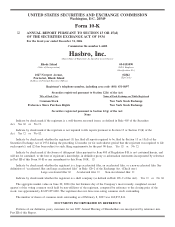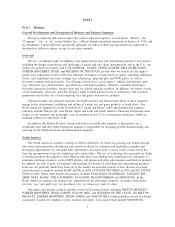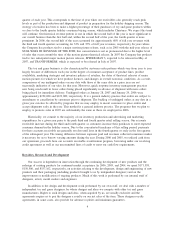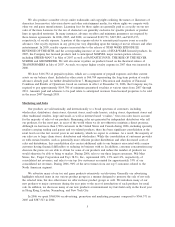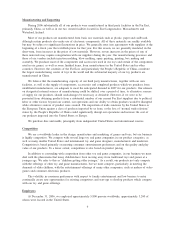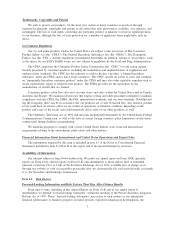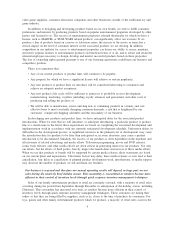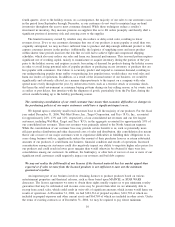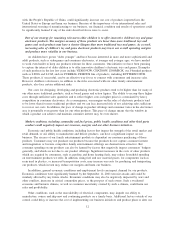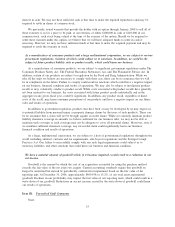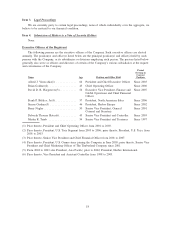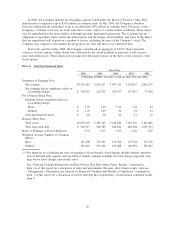Hasbro 2006 Annual Report Download - page 21
Download and view the complete annual report
Please find page 21 of the 2006 Hasbro annual report below. You can navigate through the pages in the report by either clicking on the pages listed below, or by using the keyword search tool below to find specific information within the annual report.fourth quarter, close to the holiday season. As a consequence, the majority of our sales to our customers occur
in the period from September through December, as our customers do not want to maintain large on-hand
inventories throughout the year to meet consumer demand. While these techniques reduce a retailer’s
investment in inventory, they increase pressure on suppliers like us to fill orders promptly and thereby shift a
significant portion of inventory risk and carrying costs to the supplier.
The limited inventory carried by retailers may also reduce or delay retail sales, resulting in lower
revenues for us. If we or our customers determine that one of our products is more popular at retail than was
originally anticipated, we may not have sufficient time to produce and ship enough additional product to fully
capture consumer interest in the product. Additionally, the logistics of supplying more and more product
within shorter time periods increases the risk that we will fail to achieve tight and compressed shipping
schedules, which also may reduce our sales and harm our financial performance. This seasonal pattern requires
significant use of working capital, mainly to manufacture or acquire inventory during the portion of the year
prior to the holiday season, and requires accurate forecasting of demand for products during the holiday season
in order to avoid losing potential sales of popular products or producing excess inventory of products that are
less popular with consumers. Our failure to accurately predict and respond to consumer demand, resulting in
our underproducing popular items and/or overproducing less popular items, would reduce our total sales and
harm our results of operations. In addition, as a result of the seasonal nature of our business, we would be
significantly and adversely affected, in a manner disproportionate to the impact on a company with sales
spread more evenly throughout the year, by unforeseen events, such as a terrorist attack or economic shock,
that harm the retail environment or consumer buying patterns during our key selling season, or by events, such
as strikes or port delays, that interfere with the shipment of goods, particularly from the Far East, during the
critical months leading up to the holiday purchasing season.
The continuing consolidation of our retail customer base means that economic difficulties or changes in
the purchasing policies of our major customers could have a significant impact on us.
We depend upon a relatively small retail customer base to sell the majority of our products. For the fiscal
year ended December 31, 2006, Wal-Mart Stores, Inc., Target Corporation, and Toys ‘R Us, Inc., accounted
for approximately 24%, 13% and 11%, respectively, of our consolidated net revenues and our five largest
customers, including Wal-Mart, Target and Toys ‘R Us, in the aggregate accounted for approximately 53% of
our consolidated net revenues. These net revenues were primarily related to the North American segment.
While the consolidation of our customer base may provide certain benefits to us, such as potentially more
efficient product distribution and other decreased costs of sales and distribution, this consolidation also means
that if one or more of our major customers were to experience difficulties in fulfilling their obligations to us,
cease doing business with us, significantly reduce the amount of their purchases from us or return substantial
amounts of our products, it could harm our business, financial condition and results of operations. Increased
concentration among our customers could also negatively impact our ability to negotiate higher sales prices for
our products and could result in lower gross margins than would otherwise be obtained if there were less
consolidation among our customers. In addition, the bankruptcy or other lack of success of one or more of our
significant retail customers could negatively impact our revenues and bad debt expense.
We may not realize the full benefit of our licenses if the licensed material has less market appeal than
expected or if sales revenue from the licensed products is not sufficient to earn out the minimum
guaranteed royalties.
An important part of our business involves obtaining licenses to produce products based on various
entertainment properties and theatrical releases, such as those based upon MARVEL or STAR WARS
characters. The license agreements we enter to obtain these rights usually require us to pay minimum royalty
guarantees that may be substantial, and in some cases may be greater than what we are ultimately able to
recoup from actual sales, which could result in write-offs of significant amounts which in turn would harm our
results of operations. At December 31, 2006, we had $181,561 of prepaid royalties, $116,792 of which are
included in prepaid expenses and other current assets and $64,769 of which are included in other assets. Under
the terms of existing contracts as of December 31, 2006, we may be required to pay future minimum
10


